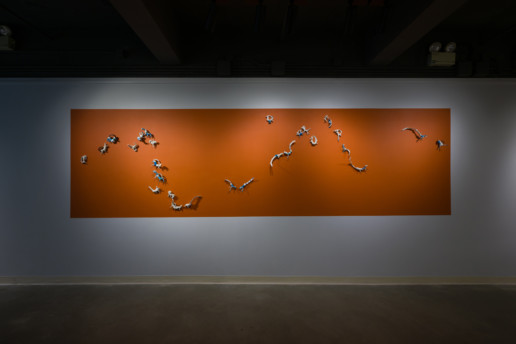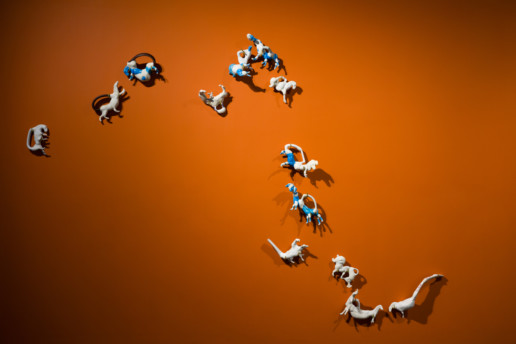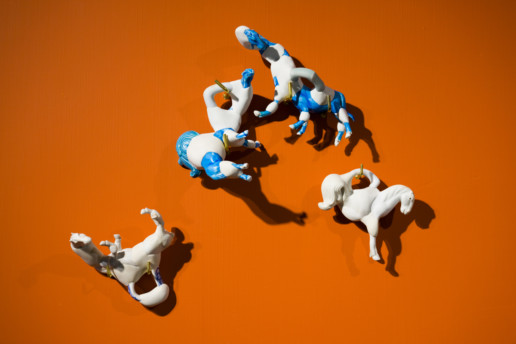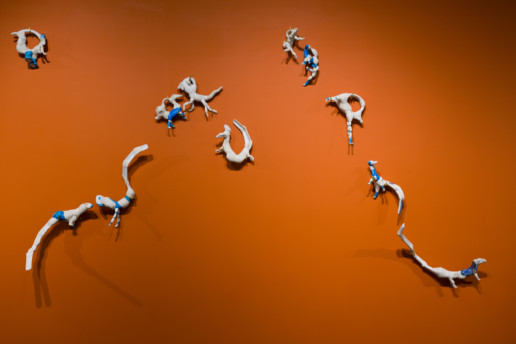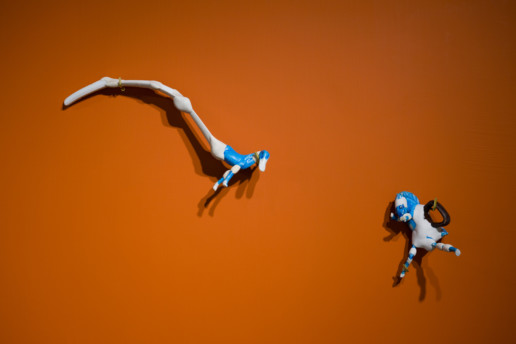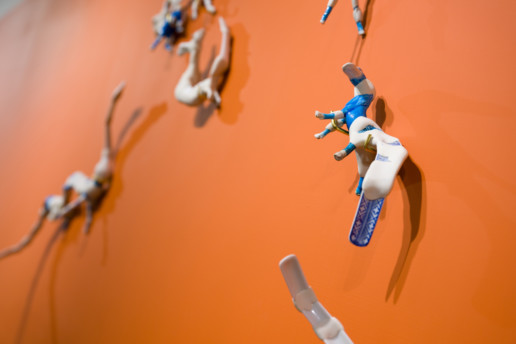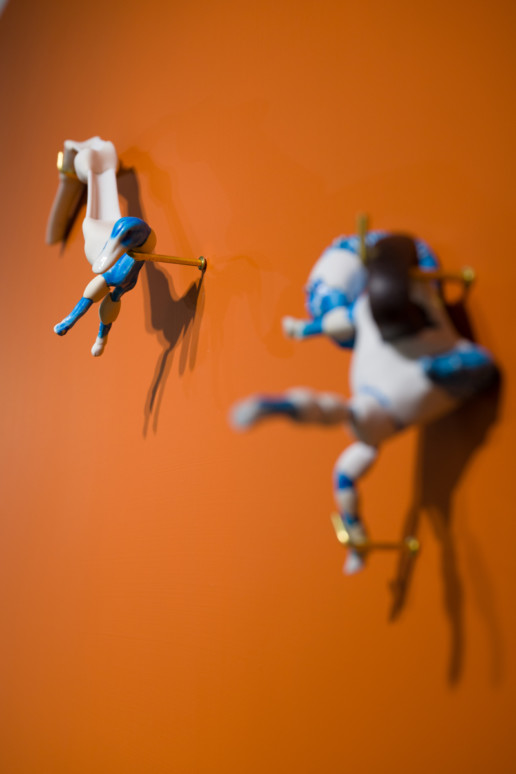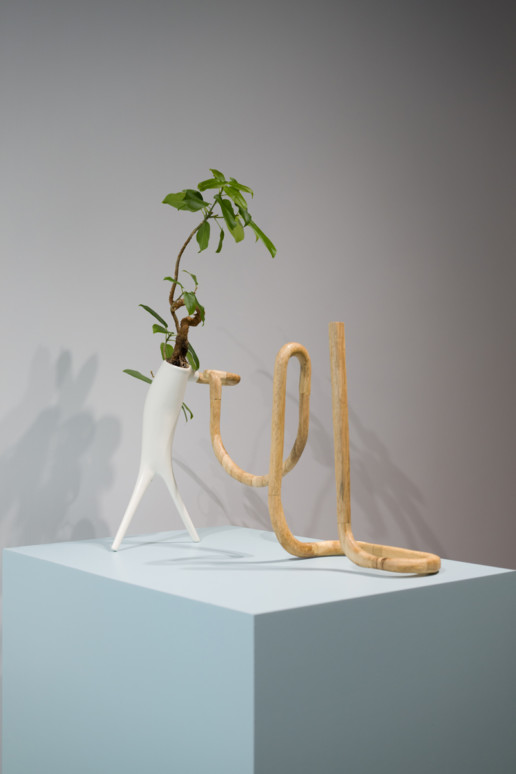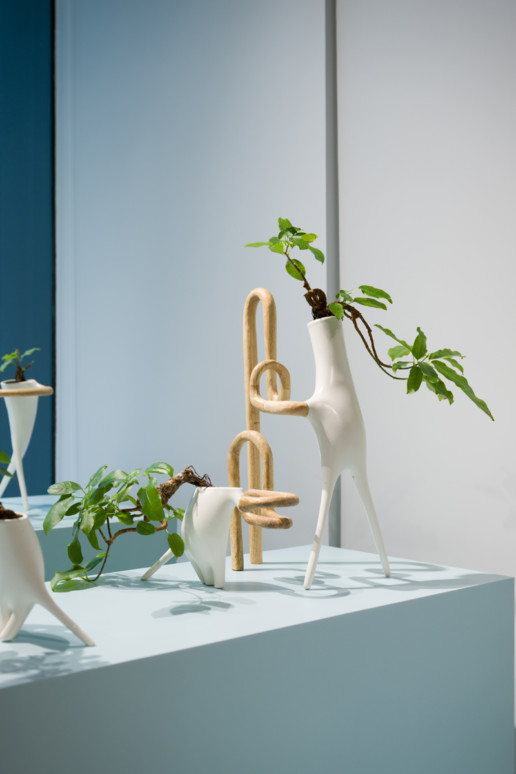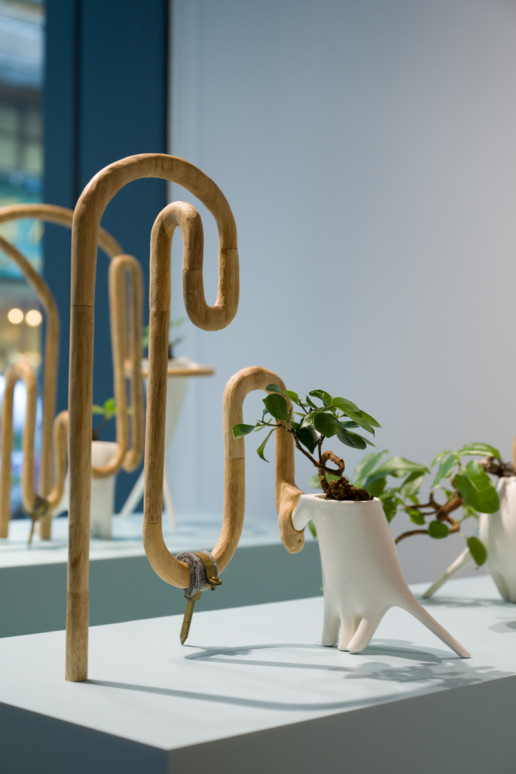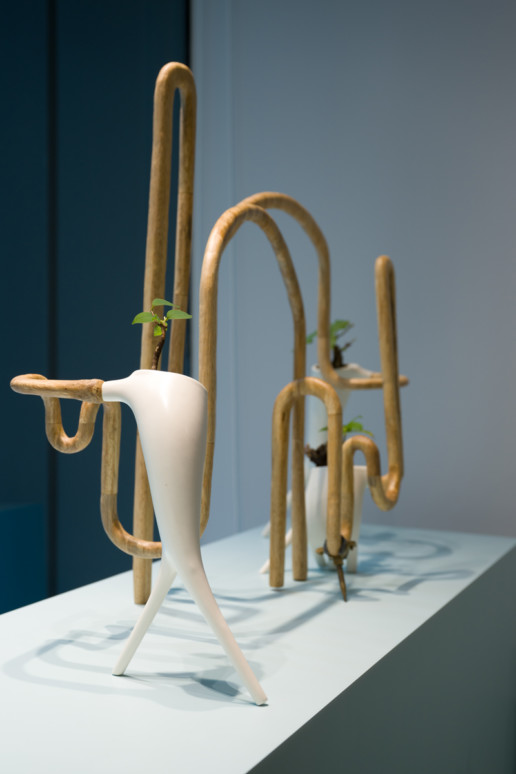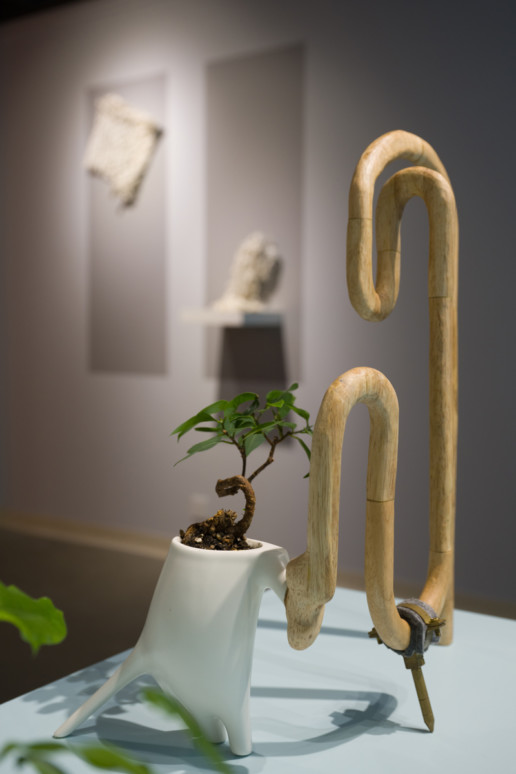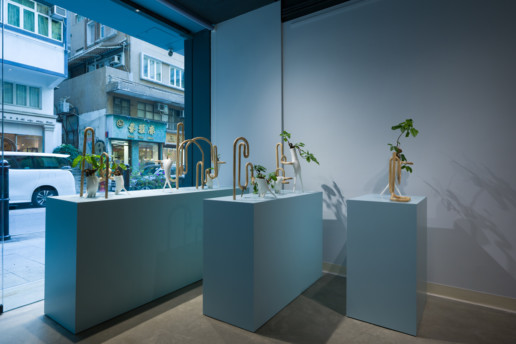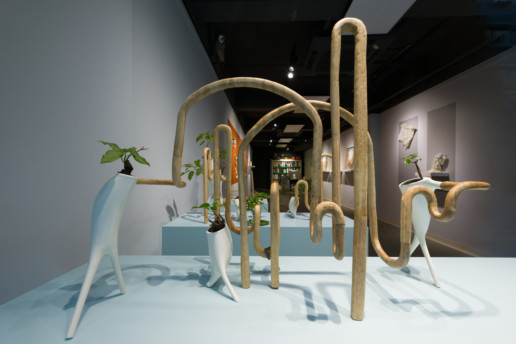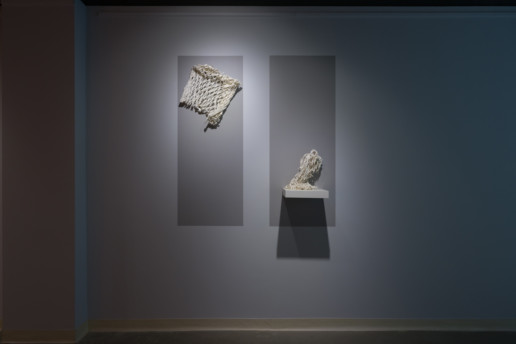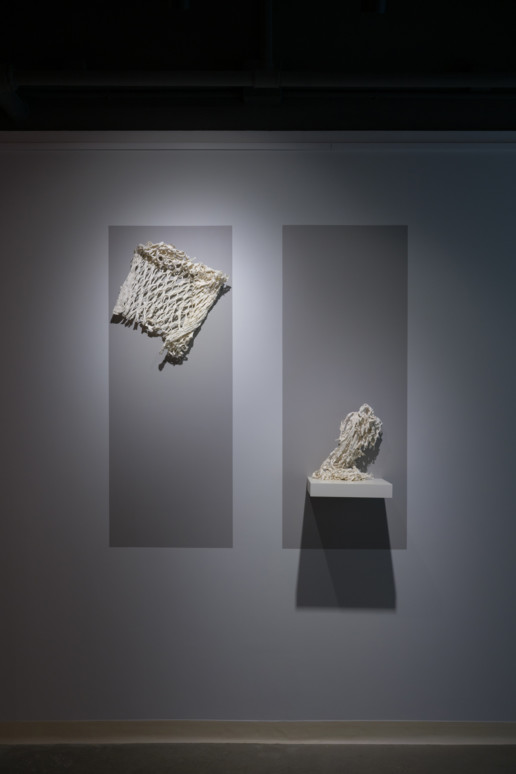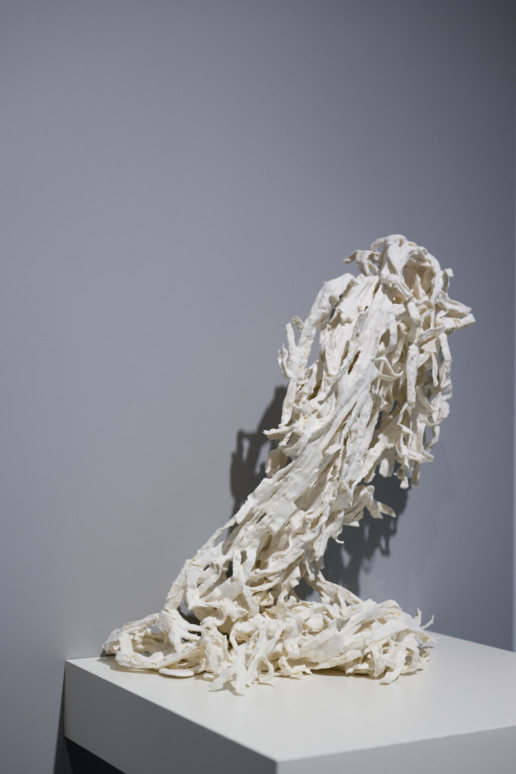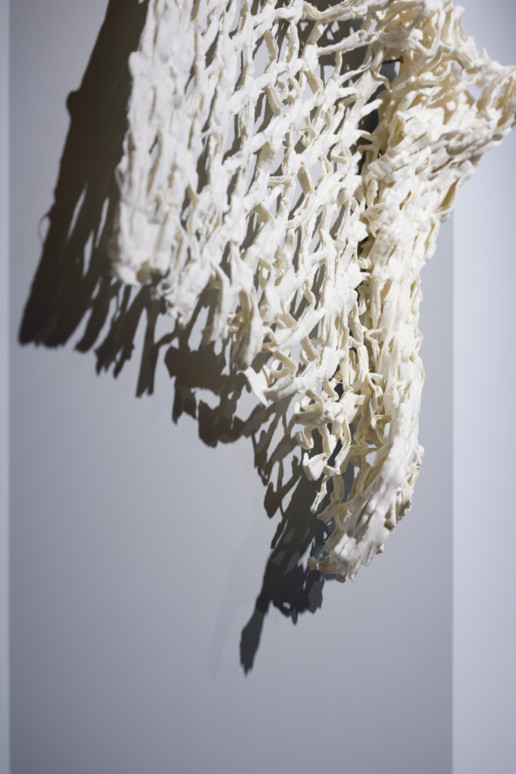For What It’s Worth: Ceramic Experimentations by Julie & Jesse
For What It’s Worth: Ceramic Experimentations by Julie & Jesse
Novalis Art Design
01 December 2023–20 January 2024
Curated by Jennifer Wong
Photo courtesy: Novalis Art Design
Rust, used cardboard wrapper, ceramic shards, roadside saplings — these are all things that we come in contact with on a regular basis, yet are so ordinary that we don’t usually register having seen them by the end of the day, and may even want to remove them to tidy up a place. But for Julie & Jesse, what are considered useless and unwanted to most are treasures to them. Each find becomes an opportunity to unpack stories across time and space, hidden within the material. The duo’s eye for curiosity and investigative approach have not only driven their entire creative practice — it is how they make sense of the world. The new works presented in this exhibition are both documentation and fruition of their ceramic experimentations in the past decade. What they create is a testimony to their superb technical skills, but it is always poetic and personal.
Rust, used cardboard wrapper, ceramic shards, saplings — these are all things that we come in contact with on a regular basis, yet are so ordinary that we don’t usually register having seen them. For Julie & Jesse, items considered useless to most are treasures. Each found object becomes an opportunity to discover the narratives hidden within the material. The duo’s curiosity and investigative approach drives their creative practice, allowing them to make sense of the world. They eschew the established values assigned to objects, whether dictated by market forces or cultural associations, and seek new ways to make use of the materials. The new works presented in this exhibition are both the documentation and culmination of their ceramic experimentations based on resources mined from the urban environment in the past decade. What they create is a poetic and personal testimony to their superb craftsmanship.
Both Irony and Anomalous Artefacts have their beginnings in China’s porcelain capital of Jingdezhen, where Julie & Jesse spent much of their time from 2012 up to the outbreak of the Covid-19 pandemic in 2020. Like many of the duo’s early works, the two projects stemmed from found objects collected from visits to former factory sites. The extensive Fragment(s) series was born from casting porcelain vessels with reassembled broken plaster moulds, with the uniqueness of each piece determined by the mould’s level of decay and uncontrollable factors in the firing process. Chance still plays a major role in the making of the two newer projects, but the focus is no longer on the clay itself.
In some ways, Anomalous Artefacts is the set of works with Julie & Jesse’s highest involvement in dictating the final form to date. They painstakingly assembled new creatures by combining broken animal sculpture parts unearthed from Jingdezhen and dining ware shards found at a beach in Hong Kong. Separated by geography, the fragments appear to have nothing in common, apart from belonging to the general category of “ceramics”. But to Julie & Jesse, the shards share a lineage. In particular, the horse sculptures were done in the style of Tang dynasty clay sculptures, and were exported abroad as toys and memorabilia. A number of the dining wares carry ornamentations that reference porcelain originating from Jingdezhen. They are all commodities, most likely copies that had earned their measly value through association with the authentic original. They also shared the same fate, discarded when they were no longer deemed to have commercial or utilitarian values. But with Julie & Jesse using a reconstructive approach akin to how archaeologists treat historical fragments, combined with their fantastical imagination, the shards came back to life as new breeds of ceramic creatures, regaining value as unique works that converse across time and place.
In Irony, iron oxide is given free reign to grow on a porcelain surface, which is something unthinkable in the usual production process. More commonly known as rust, iron oxide is the culprit behind causing black spots on the flawless white. The sight of rust is also undesirable on metal surfaces, something to be polished off or remedied. In the eyes of Julie & Jesse, however, there is beauty in the organic paintings of iron oxide, which they see as abstract landscapes. The duo first tested the technique in 2017 on large eggshell porcelain bowls, which they fired and resulted in the rust staying on permanently like glaze. In this new edition, they chose to work on thin discs that give a larger flat surface for the rust to expand on while also alluding to each piece being a window transporting viewers to other worlds. The unfired iron oxide is left at its most vulnerable state, creating the paradox that rust is the frailer counterpart out of the two, and most certainly the desirable part that gives the work its character.
With the pandemic halting international travel for several years, Julie & Jesse turned their gaze to Hong Kong and their personal lives for inspiration. Unpacked is a result of reexamining their own consumption habits and Taking Root is a reflection on the controlled interaction between humans and nature in the urban environment. These projects are also experimentations that depart further away from archetypal forms in ceramics and consider new types of relationship between clay and other materials.
As artists who work with other people’s rubbish, Julie & Jesse began to examine their own waste production during the lockdown. Online shopping shipment created a sizable reserve of honeycomb packaging wrapper in their studio and home. Made from used cardboard boxes, these packing materials often end up as trash, but Julie & Jesse experimented with them and made Unpacked, a “ceramic fossil” of the source material. Under high heat in the firing process, the pores of the cardboard absorb clay in while breaking down at the same time. The resulting lattice structure reflects the unusual ceramic making process, unlocking new possibilities in form building without mould. An earlier work that also showcases the fusing of materials with clay is Terra Mobile, wherein the duo added yarn to the mixture. In both works, the ceramic body serves as the phantom record of the disintegrated source material.
In addition to ceramic shards and other industrial materials, Julie & Jesse has been picking up plants dislodged by city cleaners and extreme weather in Hong Kong. They have also been observing how plants naturally find ways to survive in the urban environment, from saplings growing from concrete cracks and crevices to moss covering wall surfaces. Taking Root is the duo’s experiment to help orphaned saplings earn a place in the city by rehousing them in ceramic housing units. It is also a way to make sense of the double standard that people have towards plants. Cut flowers and potted plants command commercial value and are expected to be cared for, whereas roadside weeds and trees are seen as unruly and somehow destructive, and need to be removed. The work poignantly highlights how humans assign arbitrary value to plants, threatening their survival in the city.
One man’s trash is another man’s treasure. It rings true particularly in this case as Julie & Jesse’s works always start with something found; a fragment mined from a city’s vast resources. But should we perpetuate existing ways of determining what is trash? What if the underlying issue goes back to how society dictates what is valuable? By fusing the city’s discarded and overlooked materials with ceramics, they bring the unseen into view and elevate the unwanted to the forefront. They may have begun their journey with clay, but over time it has become so much more. Their process of foraging, research and experimentation contributes to and becomes the work while reassigning value through creation. In their own understated yet defiant way, they protest — for what it’s worth.
Jennifer Wong is a Hong Kong-based independent curator and writer specialising in the visual cultures of East Asia. In 2021, she established Narratives Studio, which focuses on art, design and cultural content creation. Previously, Jennifer was Assistant Curator at M+ and the Victoria and Albert Museum. She holds a MA from the RCA/V&A History of Design programme and a BA in Art History from Northwestern University.
For What It’s Worth: Ceramic Experimentations by Julie & Jesse
Novalis Art Design
01 December 2023–20 January 2024
Curated by Jennifer Wong
Photo courtesy: Novalis Art Design
Rust, used cardboard wrapper, ceramic shards, roadside saplings — these are all things that we come in contact with on a regular basis, yet are so ordinary that we don’t usually register having seen them by the end of the day, and may even want to remove them to tidy up a place. But for Julie & Jesse, what are considered useless and unwanted to most are treasures to them. Each find becomes an opportunity to unpack stories across time and space, hidden within the material. The duo’s eye for curiosity and investigative approach have not only driven their entire creative practice — it is how they make sense of the world. The new works presented in this exhibition are both documentation and fruition of their ceramic experimentations in the past decade. What they create is a testimony to their superb technical skills, but it is always poetic and personal.
Rust, used cardboard wrapper, ceramic shards, saplings — these are all things that we come in contact with on a regular basis, yet are so ordinary that we don’t usually register having seen them. For Julie & Jesse, items considered useless to most are treasures. Each found object becomes an opportunity to discover the narratives hidden within the material. The duo’s curiosity and investigative approach drives their creative practice, allowing them to make sense of the world. They eschew the established values assigned to objects, whether dictated by market forces or cultural associations, and seek new ways to make use of the materials. The new works presented in this exhibition are both the documentation and culmination of their ceramic experimentations based on resources mined from the urban environment in the past decade. What they create is a poetic and personal testimony to their superb craftsmanship.
Both Irony and Anomalous Artefacts have their beginnings in China’s porcelain capital of Jingdezhen, where Julie & Jesse spent much of their time from 2012 up to the outbreak of the Covid-19 pandemic in 2020. Like many of the duo’s early works, the two projects stemmed from found objects collected from visits to former factory sites. The extensive Fragment(s) series was born from casting porcelain vessels with reassembled broken plaster moulds, with the uniqueness of each piece determined by the mould’s level of decay and uncontrollable factors in the firing process. Chance still plays a major role in the making of the two newer projects, but the focus is no longer on the clay itself.
In some ways, Anomalous Artefacts is the set of works with Julie & Jesse’s highest involvement in dictating the final form to date. They painstakingly assembled new creatures by combining broken animal sculpture parts unearthed from Jingdezhen and dining ware shards found at a beach in Hong Kong. Separated by geography, the fragments appear to have nothing in common, apart from belonging to the general category of “ceramics”. But to Julie & Jesse, the shards share a lineage. In particular, the horse sculptures were done in the style of Tang dynasty clay sculptures, and were exported abroad as toys and memorabilia. A number of the dining wares carry ornamentations that reference porcelain originating from Jingdezhen. They are all commodities, most likely copies that had earned their measly value through association with the authentic original. They also shared the same fate, discarded when they were no longer deemed to have commercial or utilitarian values. But with Julie & Jesse using a reconstructive approach akin to how archaeologists treat historical fragments, combined with their fantastical imagination, the shards came back to life as new breeds of ceramic creatures, regaining value as unique works that converse across time and place.
In Irony, iron oxide is given free reign to grow on a porcelain surface, which is something unthinkable in the usual production process. More commonly known as rust, iron oxide is the culprit behind causing black spots on the flawless white. The sight of rust is also undesirable on metal surfaces, something to be polished off or remedied. In the eyes of Julie & Jesse, however, there is beauty in the organic paintings of iron oxide, which they see as abstract landscapes. The duo first tested the technique in 2017 on large eggshell porcelain bowls, which they fired and resulted in the rust staying on permanently like glaze. In this new edition, they chose to work on thin discs that give a larger flat surface for the rust to expand on while also alluding to each piece being a window transporting viewers to other worlds. The unfired iron oxide is left at its most vulnerable state, creating the paradox that rust is the frailer counterpart out of the two, and most certainly the desirable part that gives the work its character.
With the pandemic halting international travel for several years, Julie & Jesse turned their gaze to Hong Kong and their personal lives for inspiration. Unpacked is a result of reexamining their own consumption habits and Taking Root is a reflection on the controlled interaction between humans and nature in the urban environment. These projects are also experimentations that depart further away from archetypal forms in ceramics and consider new types of relationship between clay and other materials.
As artists who work with other people’s rubbish, Julie & Jesse began to examine their own waste production during the lockdown. Online shopping shipment created a sizable reserve of honeycomb packaging wrapper in their studio and home. Made from used cardboard boxes, these packing materials often end up as trash, but Julie & Jesse experimented with them and made Unpacked, a “ceramic fossil” of the source material. Under high heat in the firing process, the pores of the cardboard absorb clay in while breaking down at the same time. The resulting lattice structure reflects the unusual ceramic making process, unlocking new possibilities in form building without mould. An earlier work that also showcases the fusing of materials with clay is Terra Mobile, wherein the duo added yarn to the mixture. In both works, the ceramic body serves as the phantom record of the disintegrated source material.
In addition to ceramic shards and other industrial materials, Julie & Jesse has been picking up plants dislodged by city cleaners and extreme weather in Hong Kong. They have also been observing how plants naturally find ways to survive in the urban environment, from saplings growing from concrete cracks and crevices to moss covering wall surfaces. Taking Root is the duo’s experiment to help orphaned saplings earn a place in the city by rehousing them in ceramic housing units. It is also a way to make sense of the double standard that people have towards plants. Cut flowers and potted plants command commercial value and are expected to be cared for, whereas roadside weeds and trees are seen as unruly and somehow destructive, and need to be removed. The work poignantly highlights how humans assign arbitrary value to plants, threatening their survival in the city.
One man’s trash is another man’s treasure. It rings true particularly in this case as Julie & Jesse’s works always start with something found; a fragment mined from a city’s vast resources. But should we perpetuate existing ways of determining what is trash? What if the underlying issue goes back to how society dictates what is valuable? By fusing the city’s discarded and overlooked materials with ceramics, they bring the unseen into view and elevate the unwanted to the forefront. They may have begun their journey with clay, but over time it has become so much more. Their process of foraging, research and experimentation contributes to and becomes the work while reassigning value through creation. In their own understated yet defiant way, they protest — for what it’s worth.
Jennifer Wong is a Hong Kong-based independent curator and writer specialising in the visual cultures of East Asia. In 2021, she established Narratives Studio, which focuses on art, design and cultural content creation. Previously, Jennifer was Assistant Curator at M+ and the Victoria and Albert Museum. She holds a MA from the RCA/V&A History of Design programme and a BA in Art History from Northwestern University.
Re-shape
Re-shape
Soho House
20 April–01 May 2023
Curated by Delphine Canard-Moreau and Claire Roche
Re-shape is an art exhibition organised by Children of the Mekong Hong Kong that thrives on bridging these two points of view: the unique vision of curated artists and the distinctive perspectives of unprivileged children supported by Children of the Mekong.
Re-shape is a mixed-media, cross-cultural art exhibition, an invitation to see things through a different mindset and perspective, an invitation to reimagine a better world. The artworks the artists are sharing for the exhibition give us hope despite the challenges our environment faces.
Re-shape resonates with Children of the Mekong’s mission to provide disadvantaged children with education support to help them pursue meaningful professional careers. And, thus, re-shape their own future…
Re-shape
Soho House
20 April–01 May 2023
Curated by Delphine Canard-Moreau and Claire Roche
Re-shape is an art exhibition organised by Children of the Mekong Hong Kong that thrives on bridging these two points of view: the unique vision of curated artists and the distinctive perspectives of unprivileged children supported by Children of the Mekong.
Re-shape is a mixed-media, cross-cultural art exhibition, an invitation to see things through a different mindset and perspective, an invitation to reimagine a better world. The artworks the artists are sharing for the exhibition give us hope despite the challenges our environment faces.
Re-shape resonates with Children of the Mekong’s mission to provide disadvantaged children with education support to help them pursue meaningful professional careers. And, thus, re-shape their own future…
















